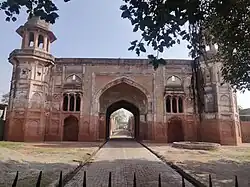| Sarai Amanat Khan | |
|---|---|
 | |
| General information | |
| Architectural style | Mughal |
| Country | India |
| Coordinates | 31°30′34″N 74°41′18″E / 31.5095349°N 74.6883201°E |
Sarai Amanat Khan is a caravanserai located in the Indian state of Punjab.[1] It is listed as a monument of national importance.[2]
History
The sarai was commissioned by Amanat Khan Shirazi, a calligrapher known for his work on the Taj Mahal.[3] He intended it to be a memorial to his brother Afzal Khan. Amanat Khan died in 1644–1645, and was buried within the sarai.[4]
Description
The sarai enclosure is almost square, measuring 168 m long and 165 m wide, with an octagonal bastion on each corner.[2][3]

Gateways
The eastern and western sides have monumental gateways. The gateways have an entrance arch, with the spandrels decorated with colorful tiles.[3] The gates are known as Lahore gate and Delhi gate.[5]
Mosque
The mosque is located in the southern half of the sarai. It has a facade of three arched openings, and was originally decorated with glazed tiles.[3]
References
- ↑ "Sarai Amanat Khan: Mughal era caravan sarai". The Economic Times. 2008-05-29. ISSN 0013-0389. Retrieved 2023-11-09.
- 1 2 Inventory of Monuments and Sites of National Importance (Vol. I, Part 2) - Chandigarh Circle (PDF). New Delhi: Archaeological Survey of India. 1999. p. 134.
- 1 2 3 4 Parihar, Subhash. Mughal Monuments in the Punjab and Haryana (PDF). pp. 21–22.
- ↑ Begley, Wayne (1985). Monumental Islamic Calligraphy from India.
- ↑ "Hope revived for Sarai Amanat Khan as ASI finds four buried cells". The Times of India. 2017-04-22. ISSN 0971-8257. Retrieved 2023-11-09.